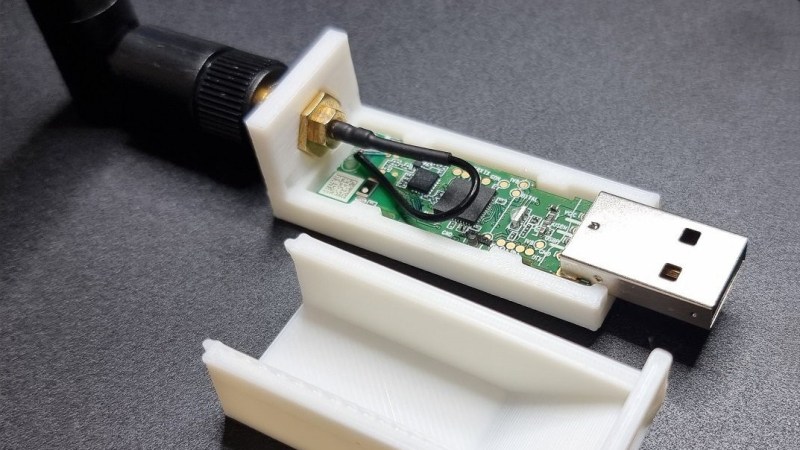[rafii6312]’s Corsair HS80 wireless headset had a big problem: short range. The sound quality was great, but the wireless range wasn’t winning any friends. Fortunately, the solution was just to swap the small SMT antenna on the USB transmitter for an external one.

This particular headset relies on a USB dongle to transmit audio from PC to headset over its own 2.4 GHz wireless connection. By popping open the USB dongle, [rafii6312] was able to identify an SMT antenna and easily desolder it, replacing it with a wired connection to a spare 2.4 GHz external antenna. That’s all it took to boost the headset’s range from barely one room to easily three rooms, which is a success by any measure.
Sadly, the USB transmitter dongle doesn’t have any intention of being opened and puts up a fight, so the process was a bit destructive. No problem, [rafii6312] simply fired up Fusion360 to design a new 3D-printed enclosure that accommodated the new antenna. Pictures, instructions, and 3D model files are all available on the project page, if you want to improve your headset, too.
This kind of antenna upgrade is reasonably straightforward, but if one is armed with the right knowledge, antenna upgrades from scratch using scrap wire and dollar store hardware are entirely possible. Just be sure to pick an antenna that doesn’t weigh down your headset.

















USB transceiver, not only transmitter.
I need to do this with the headphones themselves, since there’s no base station dongle. Just uses the main wifi/bluetooth antennas.
I’ve solved that with an external WiFi/Bluetooth adapter, with dual antennas. My wife’s headset works fine all around the apartment.
I have an inexpensive gaming headset (Mpow Air SE Wireless) and the integrated antenna is much like on the esp8266. It has excellent range for the incoming audio but oddly the microphone range isn’t great but the audio it produces is top notch when in range
Does this mean the microphone antenna is separate from the other audio? Perhaps even like this awful SMT?
Probably rather that the incoming audio is transmitted with a stronger signal from the PC which has plenty of power, whereas the headset transmits at a lower power due to the small battery.
Makes perfect sense, thank you for the reply.
I see no impedance matching of the antenna despite footprints for doing so. Furthermore the co-planar waveguide implementation between the antenna switch and the antenna itself is also far from ideal. Only one side is grounded despite that the geometries are identical to other parts of the board.
It’s pretty hard to tell what the Smith chart looks like just by looking at a picture of a board. It looks like an engineer did the schematic design based on an appnote and left spaces for all potential components to add elaborate filtering and/or matching. Likely they’re not needed in production. Then they gave it to a layout artist that can’t tell RF layout from a hole in the ground who just translated the schematic. Rubbish. Then they gave it to a test engineer in manufacturing who said, “I only need a cap and two zero ohm jumpers to make this thing work in the same room”, and that’s the BOM they went with.
I hate how accurate your prediction is likely to be.
This is literally what had to have happened lol
2.4ghz increase the range with a slotted waveguide. Back in thé early days of wifi, with a 12 slots antenna i could a 30km range link in omnidirectionnal.
Back then the band wasn’t saturated with all sorts of other similar transmissions. S/N ratio is a gotcha too
Would this trick work on Logitech g933 transceiver?
Wireless headphones are great, but 99% of them have poor range. I use a directional antenna for my BLE 5.2 dongle. Before that I would lose signal after leaving the room. Now the signal covers the entire house. It took me several different dongles and antenna’s to come up with a combination that worked. I actually use a wired pair of headphones with a BLE receiver and it works better than 300$ headphones. I use this antenna https://www.tindie.com/products/lspoplove/dstike-10db-directional-antenna-esp07esp32-wrover/ with an Intel Wi-Fi 6E AX210.